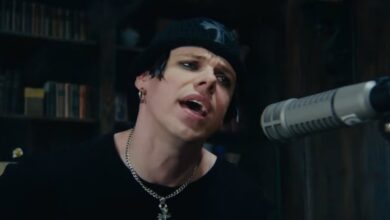Jadyn Rylee and Sina’s Mesmerizing Cover of “The Sound of Silence” Proves Timeless Music Knows No Age
The first time many listeners stumbled onto Jadyn Rylee and Sina’s “The Sound of Silence,” it felt less like finding a YouTube cover and more like opening a time capsule with a surprise soundtrack. Here were two young creators—one a vocalist with a startlingly mature tone, the other a drummer with studio-ready poise—meeting a 1960s folk standard at full emotional tilt. The result wasn’t just “good for their age”; it sounded intentional, architected, and strangely inevitable, the kind of collaboration you assume existed long before you actually saw it scroll past in your recommendations. The audience agreed in thunderous numbers, returning to replay the ache, the hush, and the slow-build catharsis that make the duo’s take linger long after the last note.
Part of the intrigue comes from how the project began. Jadyn was just eleven when she started gaining attention online, an age at which most singers are still testing their range in private. Instead, she was stepping into one of the most covered songs in modern history and doing it without the safety net of studio spectacle. Her own account of those early days is refreshingly matter-of-fact—this was simply what she did, and then, unexpectedly, millions watched. That origin story explains the unforced quality in her delivery; it’s earnest without being naive, steady without feeling rehearsed, and—most importantly—true to the lyric’s hushed, confessional spirit.
Sina’s side of the partnership brings a different magic: infrastructure. Beyond her polished pocket and clean, song-first touch, there’s a production ecosystem around her channel that favors nuance over flash. In the video notes for a sister upload of the same collaboration, you can see the credits spelled out like a miniature liner note set—arranger and keyboardist Rick Benbow shaping the orchestral bed, and Sina’s father adding bass and guitars. That credit roll tells you a lot about the seriousness of the effort; this isn’t a casual “jam in a room,” but a deliberate attempt to frame Jadyn’s voice inside harmonies, strings, and dynamics that rise and fall like a living thing.
That attention to arrangement matters with “The Sound of Silence,” a song whose power often lies in what’s withheld rather than what’s announced. Here, the production dials in space and restraint, leaving Jadyn enough room to paint vowels in air while Sina punctuates phrases with tom swells and cymbal ghosts rather than brute force. The opening is nearly weightless, and when the lift comes, it feels earned, like a dawn you can sense before you see it. The sonic palette is familiar but not derivative—echoes of the original’s intimacy sit alongside a cinematic shimmer more aligned with modern re-imaginings.
Context helps explain why this cover connected. For a new generation, “The Sound of Silence” resurfaced in pop culture when Disturbed’s 2015 version turned the folk classic into a slow-burn juggernaut, earning chart placements across multiple countries and eventually crossing the billion-view threshold on YouTube. That revival broadened the song’s audience beyond 1960s nostalgia, inviting young artists to approach it with a fresh dramatic vocabulary—lower keys, orchestral swells, pensive pacing. Jadyn and Sina’s take lives in that lineage: respectful of the original, aware of Disturbed’s shadow, yet confident enough to find its own center of gravity.
The numbers are the easiest proof that something special happened. Across uploads and shares, the collaboration’s principal video has sailed past the eight-figure mark, with the flagship YouTube post alone showing well over 30 million views—staggering for a performance anchored by two young creators working largely outside the big-label machinery. That kind of reach doesn’t come from novelty; it’s a slow, steady accumulation of word of mouth, recommendation algorithms, and people privately sending the link to friends with a simple “listen to this.” It’s virality at human scale, multiply renewed every time someone hits replay.
There’s also a backstage story worth telling, and the best place to glimpse it is through Sina’s “Girls Got Groove” world—a site and community that document her collaborations and champions the idea that young artists can build careers through carefully crafted online releases. She has written about working with Jadyn from a very young age and watching several projects explode on social media, not by accident but through craft and consistency. You feel that continuity in this cover: a team that understands audio, camera, arrangement, and audience, and knows how to make all of it serve the song rather than overshadow it.
Listen closely and the performance functions almost like a masterclass in dynamics. The first verse is soft-edged, almost whispered into the microphone; by the second verse, consonants carry more weight, and the drum accents have shifted from atmosphere to pulse. When the arrangement finally blossoms—strings widening, piano laying down a more insistent harmonic grid—the vocal rises without flipping into melodrama. That balancing act is hard to teach. It’s the difference between covering a standard and embodying a narrative, between repeating a melody and rendering a mood you can’t quite name.
Another reason the video sticks is the way it blends familiarity with small jolts of surprise. Drummers often overpower “Silence” in cover settings; here, Sina resists the urge, offering a transparent groove that opens space rather than filling it. Likewise, there’s a restraint in the piano and orchestral pads that keeps the track from tipping into pastiche. It’s emotionally big but sonically clean, a choice that gives the vocal more authority. Every swell arrives with purpose; every decay feels like a meaningful exhale rather than a fade-out for convenience.
If you’re mapping Jadyn-and-Sina’s collaboration over time, this cover sits inside a broader arc. They didn’t stop with one song; they kept exploring classic-rock pillars and folk standards, sometimes adding other young players to the mix. The trio version of “Stairway to Heaven” with guitarist Andrei Cerbu is a fan favorite precisely because it repeats the same recipe—respect the blueprint, build a modern frame, and let the melody speak. That continuity tells you this wasn’t a lucky one-off. It’s a method that scales, and “Silence” was the proof of concept.
There’s also the matter of authorship—and here the credits matter. Rick Benbow’s arranging hand is gentle but unmistakable, especially in the way strings slide in under the pre-chorus and how the piano rarely competes with the vocal line. Family involvement adds another layer of warmth: Sina’s father laying down supportive bass and guitar tracks creates a through-line between the channel’s home-grown ethos and its professional sheen. It’s a small detail, but it reinforces why the video feels intimate even when the crescendos swell.
For Jadyn, the cover’s impact wasn’t just numerical; it was directional. In later profiles she points to “The Sound of Silence” as the performance that opened doors and clarified her lane—dramatic storytelling through melody, delivered with an old-soul calm. If you watch her later releases, you can trace that identity hardening into confidence. The song didn’t typecast her; it gave her a platform to prove that poise wasn’t a fluke and that her voice could shoulder heavier emotional loads without bending out of shape.
The audience is part of the story, too. Scroll the comments and you’ll find a cross-section of generations—a boomer who loves the original, a Disturbed fan who arrived by algorithmic accident, a teen who heard the track on a short and hunted down the full version. What unites them is the same surprise: “I didn’t expect it to hit this hard.” That’s the hallmark of enduring covers—they create a second entry point into a classic, not to replace the first, but to give the next wave of listeners a doorway that feels built for them.
It helps that “The Sound of Silence” itself keeps renewing its cultural passport. The Disturbed revival reset expectations for how dark and weighty a modern cover of the song could be, winning praise from Paul Simon and planting the track back into the public square for a generation that wasn’t around when the duo first wrote it. Jadyn and Sina’s version offers a complementary lens—less operatic thunder, more luminous hush—proving the song can hold multiple dramatic temperatures and still feel like itself. That elastic quality is why it keeps returning.
What ultimately makes this collaboration special isn’t any one performance trick but the chemistry of approach. Jadyn sings like she trusts silence as much as sound; Sina plays like she trusts the vocal more than the drum fill. The arrangement trusts the listener to wait for the payoff. Put those instincts together and you get a cover that feels both handcrafted and inevitable, like it belonged to the internet long before it reached millions of screens. That’s why the numbers kept climbing—and why the link still gets passed around in private messages that say only, “You need to hear this.”
Even years later, the collaboration reads less like a viral spike and more like the cornerstone of a growing catalog. On Sina’s channels and playlists, you can see how this approach to classic material—careful credits, collaborative ethos, reverent but modern sonics—became a template for subsequent projects. The cover’s success didn’t end at a view counter; it built a playbook for sustainable, artist-first production on platforms that reward speed over craft. That, arguably, is its quietest and most important legacy.
And so “The Sound of Silence” keeps doing what it has always done: it finds new voices to carry it. In this case, those voices (and sticks) belonged to two young artists who treated the song like a living document—open to interpretation, sturdy under pressure, haunting in any era. They didn’t try to out-sing Simon & Garfunkel or out-dramatize Disturbed; they tried to tell the truth as they felt it, with tools they understood and a team that knew how to listen. That’s why the video still feels fresh, and why its comment threads keep welcoming newcomers who write the same two words: “chills again.”





